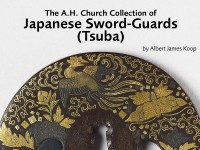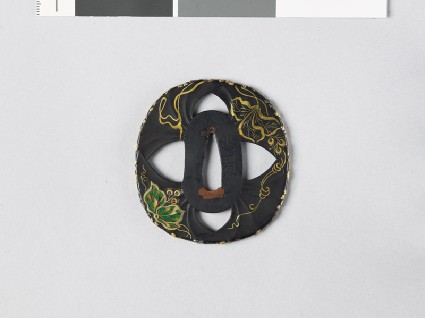The A. H. Church Collection of Japanese Sword-Guards (Tsuba)
An unpublished catalogue of the A. H. Church collection of Japanese sword-guards (tsuba) by Albert James Koop.

Publications online: 1264 objects
Tsuba in the form of gingko leaves
-
Literature notes
Thin; formed as four ichō leaves radiating saltire-wires from the sd.; they overlap, leaving four openings, and the venation is softly modelled; in rich flush inlay and gold-cloisonné enamel are the leaves, tendrils and fruits of a creeper, also a sign [Figure] of unknown meaning; edge inlaid with numerous irregular blobs of gold and silver. Signed: Hirata (as a gold-cloisonné double-gourd shaped seal with red ground), and in roughly engraved characters on the other face, Tadakage [Japanese text]. (Unrecorded.)
An outstanding piece. W. L. Behrens Collection, no.1671, plate XXIX. -
Details
- Associated place
- Date
- c. 1800
- Material and technique
- shakudō, with cut and filed openwork decoration, inlaid with gold and silver, and with gold wire cloisonné enamel; tang-hole plugged with soft metal, probably copper
- Dimensions
- 6.7 x 6.3 cm (height x width)
- Material index
-
processed material › metal › alloy › copper alloy › shakudō,processed material › metal › gold,
- Technique index
-
cut,
- Object type index
-
arms/armour › koshirae › kodogu › tsuba
- No. of items
- 1
- Credit line
- Bequeathed by Sir Arthur H. Church, 1915.
- Accession no.
- EAX.11177
-
Further reading
Koop, Albert James, The A. H. Church Collection of Japanese Sword-Guards (Tsuba), 3 vols (Oxford, Ashmolean Museum, 1929), no. 1177
Glossary (3)
cloisonné, shakudō, tsuba
-
cloisonné
Decorative technique in which wires are attached to a metal body and coloured enamels are applied between the wires.
-
shakudō
alloy of copper and gold, patinated to a dark blue-black colour
-
tsuba
Japanese sword guard.
Location
-
- currently in research collection
Objects are sometimes moved to a different location. Our object location data is usually updated on a monthly basis. Contact the Jameel Study Centre if you are planning to visit the museum to see a particular object on display, or would like to arrange an appointment to see an object in our reserve collections.
Publications online
-

The A. H. Church Collection of Japanese Sword-Guards (Tsuba)
Thin; formed as four ichō leaves radiating saltire-wires from the sd.; they overlap, leaving four openings, and the venation is softly modelled; in rich flush inlay and gold-cloisonné enamel are the leaves, tendrils and fruits of a creeper, also a sign [Figure] of unknown meaning; edge inlaid with numerous irregular blobs of gold and silver. Signed: Hirata (as a gold-cloisonné double-gourd shaped seal with red ground), and in roughly engraved characters on the other face, Tadakage [Japanese text]. (Unrecorded.)
An outstanding piece. W. L. Behrens Collection, no.1671, plate XXIX.
Notice
Object information may not accurately reflect the actual contents of the original publication, since our online objects contain current information held in our collections database. Click on 'buy this publication' to purchase printed versions of our online publications, where available, or contact the Jameel Study Centre to arrange access to books on our collections that are now out of print.
© 2013 University of Oxford - Ashmolean Museum

